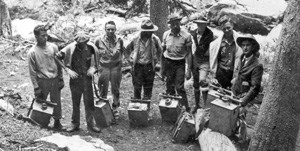
Credit: Colorado Parks and Wildlife Fish species known to be native to the area that became Rocky Mountain National Park are trout, suckers and sculpins. 
Right: Greenback cutthroat trout (Oncorhynchus clarkii stomias) These two species of cutthroat trout are native to the waters of Rocky Mountain National Park. 
NPS Photo History of Fisheries in Rocky Mountain National ParkFish stocking in the area that became Rocky Mountain National Park began in 1886 and continued with the State of Colorado stocking tens of thousands of fish on an annual basis. In the early 1900's, fish hatcheries were constructed in the towns of Estes Park and Grand Lake. These hatcheries produced hundreds of thousands of fish annually. The majority of these fish were non-native trout species which were stocked into historically fishless waters. 
NPS Photo What Fish Species Live in Rocky Mountain National Park?To learn more about the species of fish (and all wildlife) that live in Rocky Mountian National Park, visit the IRMA Portal NPSpecies site. 
Interested in Going Fishing?
|
Last updated: August 19, 2025
